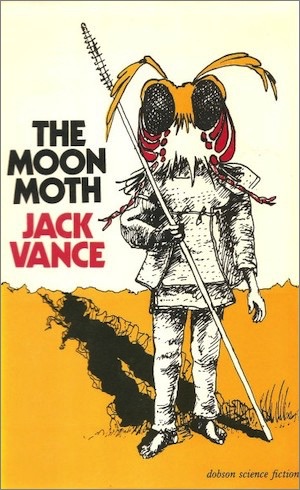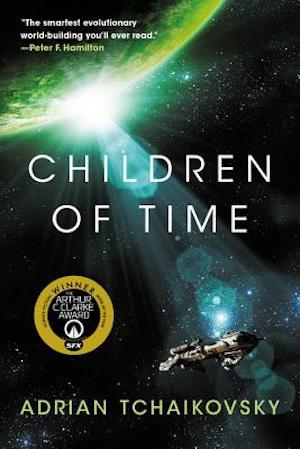Anyone wishing to learn Quenya, one of the Elvish languages, will have to get to grips with its staggeringly detailed grammar. Each noun has forty possible endings, from yulma (the cup) to yulmannar (towards the cups). It’s a perfect example of a fictional language taking on a life of its own, and becoming as linguistically complex as any organic language. Tolkien is the grandfather of these “conlangs” (constructed languages), and the tradition has continued with Duolingo adding Klingon to their stable of languages; and the publication of HBO-approved Dothraki dictionaries and courses. And yet, although the act of creating and developing them is undeniably impressive, they remain variations of human, typically European languages—with twists on morphology or phonology, but variations all the same. You can plausibly imagine Quenya or Dothraki evolving in some corner of the Baltics, just as Basque has done in south-western Europe.
My favourite languages in SFF are instead the ones that require a leap of the imagination—humans, creatures or aliens who communicate in an ingenious or unusual manner. Here are seven of the best:
Sirenese (“The Moon Moth” by Jack Vance)

All of Jack Vance’s tales brim with imagination, and it’s rather intimidating how much he packs into this short story from 1961. A society that always wears masks, where showing your face is as shameful as being naked, and a world where the currency is not money but strakh, or prestige. But best of all is the way the natives communicate—singing, accompanied by a range of different musical instruments to convey tone and register. Want to express cool disapproval? Just whip out your bagpipe-like stimic. Need to speak to some slaves or show your contempt? Time to clack away on the hymerkin, slapping the two wooden sections together. One of the functions of language that is not often discussed, is how it can deliberately keep outsiders outside: from regional slang to unique sounds [such as the click (ʘ) in African languages like Zulu and Xhosa]. In Sirene, out-worlders are instantly recognisable because they are incapable of mastering so many musical instruments, and much of the plot revolves around our narrator’s failure to blend in. Vance’s Sirenese natives sing in a wonderfully lyrical language—and its icy courtesy is never better than when they feel insulted by our narrator: “I fail to recognise the boon companion who accosts me so familiarly with his ganga.”
Pravic (The Dispossessed by Ursula Le Guin)

Some of the most inventive conlangs are where particular concepts are impossible—there simply do not exist the words to permit an idea. Pravic is a wonderful example, a language spoken by the inhabitants of the moon Anarres, that does not allow for the concept of ownership (hence the title The Dispossessed). It is a passive language, lacking personal pronouns and transactional language. So “I” is replaced by “the speaker”, and “you” by “the listener”. Instead of “my handkerchief”, you would say “the handkerchief that I use”. The society’s collectivist philosophy enforces the very grammar and syntax of the language. Or is it the other way around? For many readers, it will appear as a textbook example of the Sapir-Whorf hypothesis: that your thoughts are shaped by your native language.
When you read the dialogue of characters speaking Pravic, they can come across as stilted and aloof, and yet Le Guin shows us what a misperception that is. The passive nature of Pravic affects how we view its speakers, and it’s a valuable reminder not to mistake linguistic features for a speaker’s personality. It is an error that is easily made, for language is at the heart of many national stereotypes—think of the rising intonation of Australians; the compound nouns of German; the small syllable clusters of Spanish that allow it to be rattled off quickly. The clash between Anarres and the capitalist Urras is not just a political one, but also the fact that their languages are fundamentally contradictory.
Heptapod B (“Story of your Life” by Ted Chiang)

Human languages are linear in the way they reveal information piece by piece, but this alien tongue is two-dimensional. When our linguist narrator, Dr Banks, first hears it, she compares the sound to a “a wet dog shaking the water out its fur”. Meanwhile, the written language mirrors the radial symmetry of the aliens’ bodies – a conglomeration of rotated logograms, instead of a chronological series of words. Whereas all human writing systems throughout history would look pretty similar to a Martian, with Heptapod B, Chiang imagines a sprawling graphic language—an “Escheresque lattice”, which renders complex ideas holistically. It is unusual for a fictional language to have such focus on the written form (outside of the world of Tolkien, who apparently was not content to knock off the complete grammar and phonology of multiple Elvish languages, but designed a few scripts for them as well).
The story’s structure and plot brilliantly echo the simultaneous language of the heptapods, free from sequencing as it interleaves with Dr Banks’ past and future. It is a delight, too, to have a linguist as the hero: normally, these “first contact” stories revolve around the mutual threat, and the xenocidal Prisoner’s Dilemma played out as both species anticipate being wiped out by the other. Dr Banks, however, focusses on figuring out the linguistic puzzle, while the generals and diplomats are relegated to the background, obsessing irrelevantly over the heptapods’ intentions.
Newspeak (Nineteen Eighty-Four by George Orwell)

Many readers skip over the appendix of Nineteen Eighty-Four (dryly titled The Principles of Newspeak), but they miss out on an absolute doozy in my opinion. Orwell had already introduced so many iconic and remarkable ideas in the novel—Big Brother, Room 101, the Three-Minute Hate—that Newspeak is often overlooked. Consider the key features of Newspeak: the only language that intentionally gets smaller every year! A language whose acknowledged purpose is to limit political thought! A sample Newspeak sentence from The Times is enough to chill the blood: “Oldthinkers unbellyfeel Ingsoc” (or in contemporary English: “Those whose ideas were formed before the Revolution cannot have a full emotional understanding of the principles of English Socialism”). It is a grim, soulless version of English, stripped of nuance and poetry, and defined by its habit of bolting together words that are not natural bedfellows, e.g. doublepluscold—freezing.
Orwell may have been a bit of a cantankerous linguistic prescriptivist, but there are few writers better at illustrating how dangerous language can be in the service of political orthodoxy. The image of a boot stamping on a face forever has rightly gone down in legend, but the philologist Syme’s vision of the future of language is just as horrific: “Every concept that can ever be needed will be expressed by one word… with all its subsidiary meanings rubbed out and forgotten.”
Palp-semaphore and step-vibration (Children of Time by Adrian Tchaikovsky)

Tchaikovsky isn’t the first writer to give his animals a non-auditory language, but few have communicated as elegantly and imaginatively as his mutated spiders. For long-distance and basic communication, they use palp-semaphore, by which they gesture with their palps, and adjust their tone with stance and body language. Or for more complex conversation, they send vibrations along a web that stretches between multiple trees, and listen with their feet. The mighty Portia stamps and twitches and dances, a language more physically expressive than anything puny humans have managed to come up with. Palp-semaphore gives the spiders power. In the same way that language is at the root of the triumph of homo sapiens over other animals on Earth, it is what allows the hyper-evolved portia labiata to conquer its insect rivals on the planet of Kern’s World.
The humans’ reactions when they finally encounter the spiders is instructive—initially assuming them to be puppets of a higher machine intelligence before they realise they are independently communicating. The classicist Holsten is the first to spot that “these signals are language rather than instructions. It’s inefficient… Language is inefficient. It evolves organically.” It reminded me of the attitudes towards the raptors in Jurassic Park and the dawning horror as they realised the dinosaurs’ non-verbal communication was just as intelligent as our own: “Clever girl…” A valuable lesson that there is nothing intrinsically advanced about speech as a medium of communication.
Láadan (Native Tongue by Suzette Haden Elgin)

If you’re in the Sapir-Whorf camp, it’s hard to argue with the idea that most Western languages are male-centred. Elgin tried to challenge this by creating a female-centred language for her Native Tongue series that expressed the perceptions of women. By the use of particles, a speaker can express how they feel about what they are saying. It is a language that embraces emotions, that makes them integral to the grammar—so the “evidential” at the end of the sentence, for example, tells us if the statement is invented, trusted, observed, perceived in a dream or self-evident. And in the same vein as that old canard about Eskimo words for snow, Láadan has three different words for menopause, five for pregnancy, and seven for menstruation. It also has a proud tradition of single words to express elaborate concepts—such as ralorolo—literally “non-thunder”, or “much talk and commotion from someone with no real knowledge of what they’re talking about or trying to do”.
Láadan is a fine example of a fictional language that has developed beyond its universe. Elgin fleshed it out, published a grammar and dictionary, and even produced a translation of the King James Bible: “the most ‘masculine’ document, linguistically”. She encouraged others to add to the language, and many supporters have taken on the challenge: the official online dictionary matches each word with its creator. Despite the original novels having a relatively small readership, the language community has lived on, with youtube lessons, clubs and online courses all available.
Eridian (Project Hail Mary by Andy Weir)

Weir’s space epic features the ultimate science nerd hero, a natural progression from The Martian but on a more epic scale. Marvel as he solves crisis after crisis in deep space with just the power of math! But for me, the most interesting element is his treatment of the alien language, Eridian. It is a non-verbal, musical language, with different chords corresponding to different concepts, where pitch can indicate the mood of the “speaker”. Alien-human co-operation in fiction is rare, and part of the reason is that it’s hard to imagine how we would learn to communicate with a language that is beyond human conception. But our science nerd logically figures it out (rather in the manner of a Victorian explorer encountering indigenous people), and is able to programme a makeshift translation system, so that man and Eridian can converse. It solves one of the awkward artifices when using any kind of foreign language in fiction: normally, the author has to act as a Babel fish in the reader’s ear—with perhaps italics and off-kilter grammar as visual signals. Weir’s solution also serves as a reasonable prediction: if English-speakers are the first humans to encounter aliens, we will almost certainly rely on technology to learn how to communicate, rather than just trying to learn their damn language!
Alex Thomson is a foreign languages teacher and the author of Spidertouch, which publishes in December 2021, and features a unique touch language called fingerspeak.











I admit I love languages, though I seem to have great difficulty learning them. In my own writing I’ve had to create “mini-con-langs”; just enough to portray the flavor of a particular species (and acknowledging that a species likely has multiple languages, just as humans do.) One of these days I’ll have to do a “complete” conlang, and these examples certainly wet my imagination.
I like the language of the sprookjes in Janet Kagan’s Hellspark, who (spoiler) communicate by motions of their feathers, which takes the humans a long time to figure out. There’s a lot of fun bits about the cultures of the various survey team members, too.
It’s fantasy, rather than scifi, and a limited vocabulary, but I love Lapine in Watership Down. Adams uses a few specific terms to convey the rabbit point of view.
I would add Becky Chambers’ chromatic language of the Aeluons.
But while many of the languages you cited are interesting, the one that stands out is the Heptapod language created by Ted Chiang. It seems to build on the mind mapping concept (from business brainstorming, not SF brain linking). It would allow for a much more nuanced communication system including not just adjectives and emotions but also competing concepts and consequences.
ʘ isn’t the only click. Wikipedia says Zulu has 15, Xhosa 18, Taa 45 to 115 (depending on how you count).
If ‘I’ doesn’t exist, how can you say ‘that I use’?
Logical languages that try to get rid of vagueness and connotations and the like are older than conlangs for fiction.
Rihan by Diane Duane. Fun fact: she devised the rules for the language and plugged them into a custom-made language generator.
For most of its history, Chinese did not have gender-specific third person pronouns. Spoken Chinese still doesn’t. Does that mean Chinese society ignores gender distinctions?
Pravic has been extended by use in ways that its framers may not have thought of – see the Pravic circumlocution for “wallow”. Now that I think about it, this is a bit like how Gene Wolfe’s Ascians managed to subvert their rote language to communicate more flexibly with one another.
Om the same book, the stripped-down, single tense Nioti, the dialect of the poor in Nio Esseia, reflects, I think, Le Guin’s concern with the apprehension of time and its relationship to morality. One who cannot perceive the passage of time, distinguish present from future, can’t make a promise and can’t participate in a moral society. And the Nioti proletariat are trapped in an unjust system for which promises are irrelevant. Their argot reflects this.
@3. And in one memorable scene, tell the Big Bad off with untranslated profanity. :D
Worth mentioning that Orwell based Newspeak on a real project to simplify English – Basic English, https://en.m.wikipedia.org/wiki/Basic_English, designed as an easy introductory language with 850 words of vocabulary, and imposed as a compulsory second language in Wells’ Shape of Things to Come.
And, of course, totalitarian states do try to simplify languages. The USSR changed the Russian alphabet, and the PRC (I think) brought in splified Chinese script (Taiwan still uses the traditional characters).
I would like to add the various kinds of communication and languages in C. J. Cherryh’s books, especially the Tca in the Chanur novels (as the Atavi books and languages already have their own series here on Tor). The Tca are snake-like methan breathers with multiple brains and the “talk/sing” words in a matrix that needs to be read in different directions, changing potential meanings with it. High stakes, when any misunderstanding might lead to violent consequences. During half of the books, the various protagonists are trying to understand other species well enough to not cause a disaster – brilliant. (And I so wish, C. J. Cherryh would bring us back into the Compact to see what became of the Hani, Kif, Tca, etc. instead of adding another book to the endless Atavi series, nice as it is.)
In Babel 17, I think Delany presages Chiang with an alien language that changes the mind of the learner (I don’t remember the name of the language, though, unless it is Babel-17).
Was that the story in which learning the language gave the user so many new pathways for thought that whole new technologies occurred to them overnight?
The Thranx in Alan Dean Foster’s “Nor Crystal Tears” have a gestural language: for example, the word tree has both a word and a hand/limb movement.
Digging into the distant past:
In Heinlein’s “Gulf” (set a generation or so before Friday), a group of ~superintelligent people speak what they call (IIRC) “Speedtalk”, which is complex enough that meanings require far fewer total sounds than English does — once you learn a huge number of phonemes.
In Sturgeon’s “Baby Is Three”, the titular character has a brilliant mind but is mute due to severe Down syndrome; he has developed a language of gesture and posture, although very few people can interpret it.
In Heinlein’s Stranger in a Strange Land, some deucedly odd things happen to and around humans who learn Martian.
I think Robert Sheckley’s novelette “Shall We Have A Little Talk?” deserves a mention. On the planet Na, the language of the Naians evolves so rapidly that people from Earth–who must establish communication before they’re allowed to invade–cannot keep up, and as such will never learn the language.
It’s massively tongue-in-cheek (cheeky evolving language?), of course, yet quite inventive.
I am glad that you remember the one SF author with a PhD in linguistics! Elgin’s book The Communipaths also takes a look at communication and language, and the lyrical narration of the Ozark trilogy in High Appalachian is well worth reading.
Eluki bes shahar’s Butterfly St Cyr series also features a highly idiosyncratic narrative, and changes in it are valuable clues about who is actually speaking in the books.